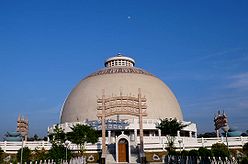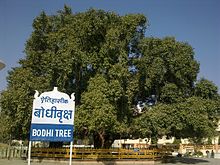- Deekshabhoomi
-
Deekshabhoomi 
DeekshabhoomiGeneral information Type Religious and historical monument. Architectural style Stupa Location Nagpur, Maharashtra, India Address Central Nagpur[1] Coordinates 21°7′41″N 79°4′1″E / 21.12806°N 79.06694°E Construction started July 1978 Inaugurated December 18, 2001 Design and construction Architect Sheo Dan Mal Deekshabhoomi is a sacred monument of Buddhism at the place where Babasaheb Ambedkar converted to Buddhism along with his about 380,000[2] followers on October 14, 1956.[3][4] Ambedkar's conversion to Buddhism is still a guidance for the masses in India.[5]
Deekshabhoomi is situated in Nagpur, Maharashtra, a location regarded as a pilgrimage center of Buddhism in India. Thousands of pilgrims visit Deekshabhoomi every year, especially on Ashok Vijaya Dashmi and the 14th of October. A great stupa is built at that place.
Deeksha literally means acceptance of religion.[citation needed] Deeksha is to Buddhism as Baptism is to Christianity.[citation needed] Bhoomi means land. So, literally Deekshabhoomi means the land where people get converted to Buddhism. Deekshabhoomi is one of the two places of great importance in the life of Ambedkar, another being Chaityabhoomi at Mumbai.
Deekshabhoomi is famous for its architectural beauty and historical importance. It is also one of the main centers of tourism in India.
Contents
History
Ambedkar had already declared in 1935 that although he was born as a Hindu he would not die as one.[6] After this declaration, he extensively studied the doctrines of all the major religions to choose Buddhism for him and his followers.[7]
He selected Nagpur for his conversion ceremony, as he explained in his speech at that occasion, because Nagpur was the homeland of Nag people who embraced Buddhism and supported it with great efforts in its early period.[8] A ground near Ramdaspeth area in Nagpur was selected for the ceremony. On October 14, 1956, Ambedkar and his wife Mrs.Savita Ambedkar took oath of Three Jewels and Five Precepts from Mahasthavir Chandramani. Ambedkar then gave the oath of Three Jewels, five precepts, and 22 Vows to his thousands of followers.
Ambedkar died on December 6, 1956, just one and a half months after this ceremony. After his death Dr. Ambedkar Smarak Samiti was organized for the management of Deekshabhoomi. The committee decided to build a Stupa at the place as a monument of that ceremony and a mass conversion of people to Buddhism.
Architecture
History of making
The stupa of the sacred Deekshabhoomi was designed by famous architect Sheo Dan Mal.[9] Construction of the stupa started in July 1978, but it took a long time to finish. Sagar Enterprise of Mumbai, (Mr. H. C. Vakharia and Mr. Sandip Vakharia,) has completed structural work. The stupa was opened for the people on December 18, 2001 after a formal inaugration by the then President of India K. R. Narayanan.[10]
Stupa
Design of the stupa at Deekshabhoomi is based upon the architecture of the world famous stupa of Sanchi. But unlike the stupa of Sanchi, Deekshabhoomi stupa is completely hollow from inside. It is the largest hollow stupa among all Buddhist stupas in the world.[citation needed] At the ground floor, there is a 211 x 211 feet large square hall. At the centre of this hall, an idol of Buddha is placed. This idol was donated to Deekshabhoomi by Thai students learning in the university of Nagpur. There is also a library and a photo exhibition of the events in the lives of Gautama Buddha and Dr. Ambedkar.
Above the hall, there is a hollow dome. This dome is surrounded by a veranda. On all the four directions of the dome, fountains are there. Above the dome, there is a small slab and a little decorative umbrella. A high quality marble from Dholpur, Rajasthan is used for the flooring of the stupa. The stupa has doors on four directions. The doors open in large arcs, which are decorated with Ashok Chakras, and statues of horses, elephants, and lions, which gives an ancient look.
Around the stupa, there is a garden which is maintained by Nagpur Improvement Trust. Statues of Dr. Ambedkar and idols Gautama Buddha are situated in front of the stupa.
Vihar and the Bodhi Tree
In front of the stupa, on the right hand side, there is a Buddha Vihara with a bronze idol of lord Buddha. Facilities are also made there for the bhikkhus to live.
Besides the Vihara, there is the Bodhi Tree, which is a sacred fig tree. This Bodhi Tree was planted at Deekshabhoomi from three branches of the Bodhi Tree at Anuradhapuram in Srilanka. Bhadant Anand Kausalyayan had brought these branches from Srilanka as the memoir of Buddha's enlightenment.[11]
Tourism
Deekshabhoomi is a prominent place of tourism for home and foreign tourists. Every year, thousands of tourists visit Deekshavhoomi, especially on the anniversary of the conversion ceremony.[12] Foreign tourists come mainly from the Buddhist countries such as Japan and Thailand.[citation needed]
References
- ^ Keer, Dhananjay (in Marathi). Dr. Ambedkar: Life and Mission.
- ^ This was Ambedkar's own figure given by him in a letter to Devapriya Valishinha dated October 30, 1956. The Maha Bodhi Vol. 65, p.226, quoted in Dr. Ambedkar and Buddhism by Sangharakshita.
- ^ "Life of Babasaheb" (Web). http://www.ambedkar.org/Babasaheb/lifeofbabasaheb.htm. Retrieved January 6, 2009.
- ^ Pritchett, francis. "In the 1950" (Web). Columbia.edu. http://www.columbia.edu/itc/mealac/pritchett/00ambedkar/timeline/1950s.html. Retrieved January 6, 2009.
- ^ Untouchables embrace Buddha to escape oppression
- ^ Pritchett, Frances. "In the 1930s" (PHP). http://www.columbia.edu/itc/mealac/pritchett/00ambedkar/timeline/1890s.html. Retrieved January 6, 2009.
- ^ His famous speech Mukti kon Pathe? at Mumbai in 1936
- ^ Pritchett, Frances. "Why was Nagpur Chosen?" (PHP). http://www.columbia.edu/itc/mealac/pritchett/00ambedkar/txt_ambedkar_conversion.html#03. Retrieved January 6, 2009.
- ^ "Dr Ambedkar memorial architect Sheo Dan Mal passes away" (Web). OneIndia. January 25, 2007. http://news.oneindia.in/2007/01/24/dr-ambedkar-memorial-architect-sheo-dan-mal-passes-away-1169695243.html. Retrieved January 5, 2009.
- ^ President K.R. Narayanan: Selected Speeches ISBN 8123011598
- ^ Page 175, Modernisation of Buddhism: Contribution of Ambedkar and Dalai Lama XIV By Lella Karunyakara ISBN 8121208130
- ^ "Thousands visit Deekshabhoomi in Nagpur" (Web). The Hindu. December 7, 2006. http://www.hindu.com/2006/12/07/stories/2006120708281200.htm. Retrieved 2008-07-05.
- Special issue of Lokrajya, the publication of Govt. of Maharashtra on silver jubilee of 1956 ceremony.
- Deeksha, Special issue of Daily Sakaal in October 2005
Nagpur-related topics History Gond · Bhonsle · Nagpur kingdom · Nagpur Province · Central Provinces · Central Provinces and Berar · Sitabuldi FortGeography Administration Nagpur Municipal Corporation(NMC) · Nagpur Improvement Trust · Nagpur District · Nagpur Division · Nagpur Police · Nagpur (Lok Sabha constituency)Education Attractions Transport & Infrastructure Dr. Babasaheb Ambedkar International Airport · MIHAN · Nagpur Railway Station · Koradi Thermal Power StationCrime Buddhism Buddhism portal Categories:- Dalit monuments
- History of Maharashtra
- Buddhism in India
- Visitor attractions in Nagpur
- Buildings and structures in Maharashtra
- B. R. Ambedkar
- Memorials to Bhimrao Ramji Ambedkar
Wikimedia Foundation. 2010.


